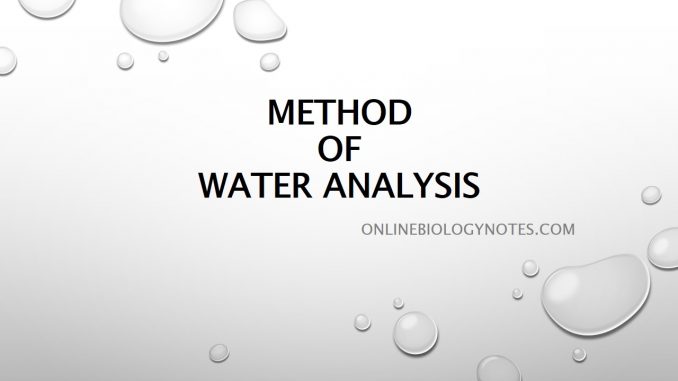
Method of water sample examination
Microbiological or bacteriological analysis of water is performed in 2 steps:
Step I: Water sample collection:
- Collection of water sample is important step in bacteriological examination of water.
- If sample collection process is not appropriate, it gives false result and raises question about validity and liability of the test.
- Water sample for analysis should be collected in sterile bottle made up of neutral glass of capacity 200-500 ml.
- Methods of water sample collection vary depending on the source of water.
i. Bottled or mineral water sample:
- In case of bottled water, at first outside of the bottle is disinfected or sterilized with chemicals like chlorine or phenol before sample collection.
- Water sample is taken out by sterile syringe through sterile portion of bottle.
ii. Jar water sample:
- In case of jar water sample, at first the covering of jar is sterilized by chemicals and then covering is removed using sterile knife.
- Finally sample water is taken out from jar using sterile pipette.
- Tap water sample:
- In case of tap water sample, at first tap is open fully for about 2 minutes to remove the microorganisms present in internal nozzle.
- Then water sample is collected in sterile collecting bottle.
iii. River, pond or lake water:
- In case of river, pond or lake water sample, sterile collecting bottle with string at neck is used to collect sample.
Step II: Water sample examination:
- There are different methods utilized for microbiological examination of water. Some of them are:
- Standard plate count method
- Most probable number method
- Membrane filtration technique
1. Standard plate count (SPC) method:
- Pour plate technique is commonly used method for standard plate count to count the microorganism (bacteria) in water.
- SPC is not considered satisfactory for bacteriological analysis of drinking water because it gives total count of all bacteria present in water but not specifically of coliform and pathogenic one. However this method is commonly used to check efficiency of water treatment plant.
- In water treatment plant, standard plate count method is carried out after each step of treatment.
- To count coliform in water, media such as crystal violet neutral red bile lactose agar (VBRL agar) is used.
- In this method, at first sample (water) is serially diluted in different test tubes, then fix volume (1ml) of diluted sample from each dilution is placed in sterile petriplate.
- Then molted agar media is poured in the petriplate, mixed with inoculum, allowed to solidify and then incubated for appropriate time and temperature.
- Colony count is made and number of bacteria in water sample is calculated with the formula:
- Colony forming unit (cfu/ml) = number of colonies * dilution factor /Volume of sample
2. Most probable number (MPN) method: multiple tube test
- MPN method is a statistical technique for counting bacteria present in water sample. This test is mainly used to count coliforms but it can also be used to count pathogens like Salmonella, Vibrio etc.
- This MPN technique gives most probable number of pathogens in water but not actual number.
- In this technique, microbial number is not directly counted but recorded from previous MPN chart.
3. Membrane filtration (MF) method:
- In membrane filtration method, water sample is first filtered through membrane filter of pore size 0.45µ
- During filtration bacterial cells are trapped on filter paper. Then the filter paper is removed and placed over the solidified agar media and incubated for 24 hours at suitable temperature.
- Bacteria form colony and these colonies are counted. Finally number of bacteria in original sample is calculated by correlating the number of colonies with volume of water filtered.

enjoyable